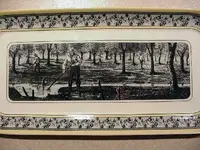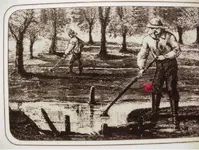Bill is on to something. We have to remember that when these guys were alive, all the old stuff we are looking for now was new stuff then. It also did not have time to bury itself in the ground or rust up so you couldn't tell what it was. There were no pop tops or pull tabs. So all they had to do was use small forked sticks with some netting to scoop all the stuff up. They had no running water so they had to use small cleaning stations designed to clean but not damage the finds. They would pour their finds in the pool, stir them around a little to clean off the dirt, and scoop them back out. It was a very popular pastime. People would spend large sums of money on the best netting for their forked sticks. They figured out ways to let the "bad" stuff pass through and only retain the most valuable things. They tried for years to make netting that would only trap gold but that was never successful. They had to take the silver with the gold and separate it later. May of the upper class would have their forked sticks hand carved out of the finest wood so they would be light and easy to use for long periods of time. Many were waterproof and could be used safely and not rot away. It is unclear why the practice stopped. The cleaning areas were abandoned and the price of netting and forked sticks plummeted. They were so cheap that some unemployed people started making slingshots with them and started a new industry that continues today. Only the material has changed but the basic design still resembles the original forked stick coin and jewelry scooper.
I think this picture on the dish is almost like a treasure map and will lead to great discoveries. I have heard of nobody that has researched and located any of these washing pools. Even though the netting technology was very advanced, the recovery from these pools could not have been 100%. None of them could have been "fished clean." There should be much left behind to find. These places may be hard to find but all you good researchers should be able to find them without too much difficulty.
I look forward to seeing numerous styrofoam plates heaped with the material left behind in these long forgotten spots.
Daryl










 cant be cranberries , they have to be harvested and specially sorted, deer berries have the same specific gravity. They have to be hand sorted. or then maybe the picture was someones wild imagination and needed to decorate the plate so they could go for a cold one
cant be cranberries , they have to be harvested and specially sorted, deer berries have the same specific gravity. They have to be hand sorted. or then maybe the picture was someones wild imagination and needed to decorate the plate so they could go for a cold one
